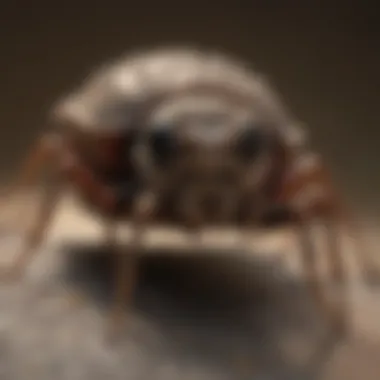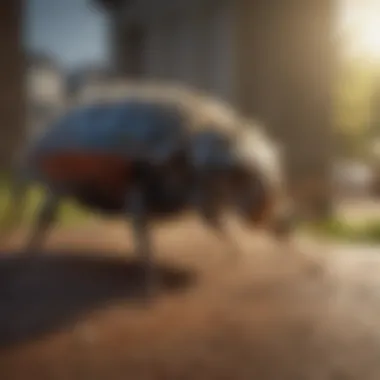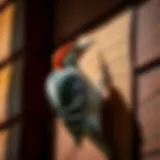Effective Pest Control Strategies in Concord, CA


Intro
Pest control is a vital aspect of maintaining a healthy and comfortable environment in our homes. Particularly in Concord, CA, the unique climate and local flora and fauna can attract a variety of pests. Understanding the specifics of pest identification, prevention, and treatment is crucial for homeowners and renters alike. This guide serves as a comprehensive resource, aiming to equip you with the knowledge to handle pest-related issues effectively.
Pest Identification
Identifying pests accurately is the first step in any effective pest control strategy. Concord, CA, is home to several common pests that can disrupt daily life.
Detailed descriptions of common pests
- Ants: Often found in kitchens and along pathways. They form colonies and can invade homes in search of food.
- Cockroaches: Notoriously resilient, these pests thrive in warm conditions. They are commonly found in basements and kitchens.
- Rodents: Rats and mice can cause significant damage. They are attracted to food sources and often leave droppings, which is a clear sign of an infestation.
- Termites: These wood-destroying insects can compromise the structural integrity of homes. Look for soft spots in wood and discarded wings around windows.
- Spiders: Although many spiders are harmless, their nests can indicate other infestations, like flies.
Signs and symptoms of infestations
Recognizing the signs of a pest infestation is essential. Common indicators include:
- Visible droppings or urine trails.
- Gnaw marks on furniture or wires.
- Nesting materials, such as shredded paper or fabric.
- Unexplained bites or itching on skin.
- Dead insects or insect parts around your home.
"Early detection is key to preventing major infestations. A proactive approach can save time and resources in the long run."
Prevention Strategies
Effective pest control begins long before an infestation occurs. Implementing sound prevention strategies can mitigate the risk of pests invading your home.
Home maintenance tips for pest prevention
- Seal Cracks and Gaps: Inspect both the interior and exterior of your home for any openings. Use caulk or foam to seal small gaps.
- Proper Food Storage: Keep food in sealed containers and dispose of garbage regularly to eliminate attractants.
- Maintain Cleanliness: Regular vacuuming and cleaning can help discourage pests from making your home their own.
- Landscaping Management: Keep shrubs and trees trimmed. Prevent plants from touching the house, as they can serve as bridges for pests.
Natural deterrents and barriers
Utilize natural methods to keep pests at bay without resorting to harsh chemicals:
- Essential Oils: Mixtures of peppermint or tea tree oil can repel various insects. Use them in sprays or diffusers.
- Diatomaceous Earth: This powder can be applied in areas where pests are present. It is non-toxic and physical in nature, harming pests without chemicals.
Treatment Options
When prevention fails, knowing effective treatment options is crucial.
Overview of chemical vs. natural treatments
Choosing the right kind of treatment involves understanding both options:
- Chemical Treatments: These often offer quick results but can have health risks for humans and pets if not applied correctly. Look for commercial products specifically designed for your pest issue.
- Natural Treatments: While they might take longer to see results, many prefer options like boric acid or vinegar solutions. These can be less harmful to both the environment and your household.
Step-by-step guides for DIY treatments
Here is a simple approach for a common issue like ant infestations:
- Identify Entry Points: Check where the ants are coming from.
- Create a Bait: Mix sugar with boric acid and place it near the entry.
- Seal Off Entry: Once the ants are gone, seal the cracks to prevent return.
Taking these steps not only tackles the current infestation but reinforces your home against future issues. Understanding these strategies can empower you to manage pests effectively.
Understanding Pest Control
Pest control is an essential aspect of maintaining a healthy and safe environment in any place, including Concord, California. Understanding pest control involves more than just knowing how to eliminate unwanted insects or animals; it addresses the comprehensive strategies involved in managing pest populations effectively and sustainably. This section will delve into the definition and importance of pest control to provide a well-rounded foundation for the subsequent discussions in this guide.
Definition of Pest Control
Pest control refers to the methods and practices employed to manage and regulate pest populations that pose a threat to human health, property, and the ecosystem. These pests may include insects, rodents, and various wildlife species that can invade homes or disrupt local environments. The process can involve a mix of prevention, monitoring, and intervention strategies to minimize pest presence, ensuring that infestations are dealt with promptly and effectively. Pest control can be categorized into three main types: preventive measures, physical control, and chemical treatments. Each category offers specific tactics that can be tailored to local conditions, particularly in regard to the unique pest populations found in Concord.
Importance of Pest Control
Understanding pest control is critical for several reasons:
- Health Protection: Pests can carry diseases, contaminate food, and cause allergic reactions. Effective pest control protects family members and pets from these health risks.
- Property Preservation: Infestations can lead to significant damage. For example, termites can compromise the structural integrity of homes. By managing pests, homeowners can protect their investments.
- Environmental Balance: Pest control also respects the local ecosystem. Sustainable methods aim to control pests without causing harm to beneficial species or the environment. Choosing integrated pest management helps maintain this balance.
- Economic Savings: Regular pest management can prevent costly damage repairs and health-related expenses. By addressing pest issues early, homeowners can save money over time.
"An ounce of prevention is worth a pound of cure." Recognizing the significance of pest control can lead to proactive measures, ensuring a comfortable living space in Concord.
Pests Commonly Found in Concord
Understanding the types of pests commonly found in Concord is essential for effective pest control. Different pests thrive in various environments and conditions. Recognizing these types allows homeowners to take preventive measures and choose appropriate control strategies. Knowing the local pest population can save time and money for those seeking to maintain a pest-free environment.
Overview of Local Pest Population
Concord's climate provides a suitable habitat for a variety of pests. This city experiences warm summers and mild winters, creating ideal conditions for pests such as ants, termites, and rodents. There are also seasonal fluctuations that impact pest activity. During warm months, some pests breed more rapidly, potentially leading to infestations. In particular, termites and ants often become more noticeable during spring and summer. Familiarizing oneself with the local pest population helps to prepare and act in a timely manner.


Termites in Concord
Termites are a significant concern for homeowners in Concord. These pests can cause considerable damage to wooden structures, often without immediate signs of their presence. They feed on cellulose, found in wood and other plant materials. In California, the most common types of termites are subterranean and drywood termites. Subterranean termites are known to build colonies in the soil, while drywood termites live within the wood they infest.
Signs of a termite infestation include:
- Mud tubes on foundations or walls
- Hollow-sounding wood
- Swarmers, which are winged termites
Addressing a termite issue promptly can prevent extensive damage. Regular inspections are crucial in spotting an infestation early.
Ant Species and Management
Ants are prevalent throughout Concord, with several species frequently encountered. The most common types include:
- Argentine Ants: These small, light-brown ants are known for forming large colonies.
- Carpenter Ants: They can damage wooden structures, similar to termites, as they excavate wood to create nests.
- Pavement Ants: Often found nesting in concrete, these ants can be a nuisance around homes.
To manage ant problems, proper identification of the species is key. Effective strategies may involve:
- Keeping food sealed and stored properly.
- Sealing entry points around the home.
- Utilizing baits or sprays specifically designed for the ant species in question.
Rodents: Identification and Control
Rodents, particularly rats and mice, are another group of pests often found in Concord. They can carry diseases and cause damage to properties.
Common signs of rodent infestations include droppings, gnaw marks, and nests made from shredded materials. Identifying whether you have house mice, roof rats, or Norway rats can influence your control methods.
To control rodent populations, consider the following:
- Sanitation: Keep areas clean and free from food sources.
- Exclusion: Seal gaps around walls and entry points.
- Trapping: Use snap traps for effective capturing.
- Professional assistance: In severe cases, seeking help from pest control services is advisable.
Recognizing these common pests and understanding their behavior can empower homeowners to take proactive steps in protecting their properties.
Identifying Pest Infestations
Identifying pest infestations is a critical step in effective pest management. Whether you are a homeowner or a renter in Concord, understanding how to recognize the signs of pests can prevent larger issues down the line. Early detection can save money, time, and stress. Pest infestations can lead to property damage, health risks, and increased pest populations if not addressed promptly. In this section, we will explore the common signs of pest activity and practical methods for detecting infestations.
Signs of Pest Activity
Being vigilant about pest activity is essential. Certain indications suggest that pests may have invaded your living space. Here is a list of common signs:
- Droppings: Finding droppings or feces is often one of the first signs of an infestation. The size and shape can vary depending on the pest.
- Gnaw Marks: Rodents and some insects create visible damage by chewing on walls, furniture, and even cables. Look for scratches or bite marks.
- Nests: Pests like mice or wasps build nests in hidden areas. Check corners, attics, and basements for any signs of nesting materials.
- Unusual Sounds: Noises such as scratching, buzzing, or scurrying usually indicate pests are present, particularly at night when they are most active.
- Visible Pests: Simply seeing a pest can be the most direct sign. Pay attention to areas near food sources or hidden spaces.
"Identifying pests early can prevent significant damage and costly repairs in your home."
These signs can help guide actions for further investigation. If any signs of pest activity are spotted, it is best to act quickly.
Methods for Detection
Detecting pests requires a variety of techniques tailored to the environment and type of pest. Here are common methods used for pest detection:
- Visual Inspections: Regularly inspecting your home for signs of pests is essential. Focus on areas such as kitchens, bathrooms, attics, and basements.
- Traps: Setting baited traps can help identify the specific type of pest present. For example, sticky traps capture crawling insects, while snap traps target rodents.
- Monitoring Devices: Some advanced products on the market can help monitor pest activity. Consider using wireless sensors that alert you to pest movements.
- Professional Inspections: Hiring a pest control professional can provide a thorough examination. They have experience and tools to find hidden infestations.
Using multiple methods increases the chances of discovering a pest problem. Identifying pest infestations is vital in taking appropriate measures for control and prevention.
Pest Prevention Techniques
Pest prevention techniques are crucial in maintaining a pest-free environment in Concord, CA. The benefits of implementing these techniques extend beyond merely reducing pest populations. They help in safeguarding your home, ensuring sanitary living conditions, and minimizing the long-term costs associated with pest management. Understanding specific elements of pest prevention can empower homeowners and renters alike to take proactive measures against infestations.
Environmental Modifications
Environmental modifications refer to changes made in and around your property to make it less conducive to pests. This could involve landscaping choices that deter pests, removing standing water, and adjusting outdoor lighting to minimize pest attraction.
- Landscaping Choices: Opt for plants that are less attractive to pests. For example, using native plants can reduce the need for chemical treatments while providing habitats for beneficial insects.
- Water Management: Ensure that areas around your home do not collect standing water, as this is a breeding ground for mosquitoes. Gutters should be cleaned regularly, and any leaks should be repaired promptly.
- Light Adjustment: Use yellow or sodium vapor lamps for outdoor lighting instead of white lights. This change can significantly decrease the number of flying insects attracted to your home.
Sanitation Practices
Sanitation practices are key in preventing pest infestations. Maintaining cleanliness in your home and surroundings can significantly reduce the attraction for pests. Effective sanitation involves a series of regular and thorough cleaning routines.
- Food Storage: Store food in sealed containers, and ensure that any spills or crumbs are cleaned promptly. This practice not only reduces the food supply for pests but also helps to maintain good hygiene.
- Waste Management: Dispose of garbage regularly and use trash cans with tight-fitting lids. This minimizes odors and prevents pests from being drawn to waste areas.
- Routine Cleaning: Regularly vacuuming and sweeping floors, especially in kitchens and dining areas, is essential. This practice removes food debris that can attract various pests.
Physical Barriers
Physical barriers play a significant role in pest prevention. Implementing these barriers can prevent pests from entering your home in the first place.
- Sealing Entry Points: Inspect your home for gaps and cracks in windows, doors, and the foundation. Sealing these entry points with caulking or weather stripping can prevent pests from gaining access.
- Screens and Mesh: Installing screens on windows and doors can keep flying insects out. Additionally, vents should be covered with fine mesh to stop rodents and other pests.
- Fences and Barriers: If you have a garden, using fencing can help keep out larger pests like rabbits and deer. Consider materials that are effective for the type of wildlife in your area.


Implementing these pest prevention techniques not only increases your comfort but also enhances your property's value and safety.
By incorporating environmental modifications, sanitation practices, and physical barriers, you create an environment that is unwelcoming to pests. These methods, when combined, provide a comprehensive approach to pest management, making it easier to maintain a pest-free home.
Chemical Pest Control Options
Recognizing the role of chemical pest control is crucial for maintaining a healthy living environment in Concord, CA. In regions where pests can flourish due to favorable climates, chemical methods can provide effective and immediate relief. This section delves into the various chemical solutions available, the application techniques employed, and the safety considerations that homeowners must keep in mind when using these methods.
Overview of Chemical Solutions
Chemical pest control solutions encompass a wide range of products designed to eliminate or manage pest populations. These include insecticides, herbicides, and fungicides, each formulated to target specific pests while minimizing impacts on the surrounding ecosystem. Common types of chemical solutions include:
- Pyrethroids: Synthetic chemicals inspired by natural insecticides found in chrysanthemum flowers. They are effective against a variety of insects, including ants and roaches.
- Neonics: A class of neurotoxic pesticides that disrupt the nervous system of insects. They are used against various pests but have raised concerns over their impact on pollinators.
- Boric Acid: Often utilized for cockroach control, it acts as a stomach poison when ingested by insects. It is also less harmful to humans and pets when used correctly.
These solutions are vital for addressing larger infestations quickly and can be part of an integrated pest management strategy.
Application Techniques
Proper application of chemical pest control products ensures effectiveness and safety. Here are commonly used application techniques:
- Direct Spraying: Involves applying chemical sprays directly onto affected areas. This method provides quick results but must be done cautiously to prevent overspray onto non-target areas.
- Baiting: This technique uses bait stations filled with poison. Pests consume the bait and often return to their nests, where they can spread the poison further, effectively reducing the population.
- Fogging: This involves dispersing a chemical solution into the air to cover a larger area, particularly for outdoor applications. Fogging is useful in treating areas with high insect activity.
Each technique has its advantages and should be chosen based on the specific pest problem and the area affected.
Safety Considerations
While chemical pest control can be effective, safety precautions must be observed to protect human health and the environment. Key considerations include:
- Read Labels: It is essential to read and follow product labels for proper application rates and safety measures. Understanding the instructions helps in avoiding misuse.
- Protective Gear: When applying chemicals, wearing gloves, masks, and goggles minimizes exposure to harmful substances. Protecting skin and respiratory systems is essential.
- Pet and Child Safety: Ensure that pets and children are kept away from treated areas. Many chemicals can pose risks if ingested or inhaled.
- Proper Disposal: Used containers and excess chemicals should be disposed of according to local regulations to prevent contamination of water sources.
"Safety is a critical aspect of pest control. Understanding how to use chemicals responsibly can protect your family while effectively managing pests."
By recognizing these safety considerations, homeowners can leverage chemical pest control effectively while ensuring a safe environment.
Natural Pest Control Alternatives
Natural pest control alternatives have gained traction in recent years among homeowners and professionals alike. As concerns about the environmental impact of chemical pesticides grow, many are looking for effective and sustainable solutions. These alternatives can help manage pest populations while minimizing harm to beneficial insects and the overall ecosystem.
Choosing natural solutions reflects a broader shift towards sustainable practices. This shift emphasizes the need for methods that not only eradicate pests but also protect human health and environmental integrity. In Concord, CA, where the unique local flora and fauna play crucial roles in pest dynamics, understanding and applying these methods become especially relevant.
Prelude to Natural Solutions
Natural pest control refers to techniques and products that utilize natural materials and processes to deter or eliminate pests. This can include methods like using essential oils, diatomaceous earth, or even introducing beneficial organisms such as ladybugs or nematodes. These approaches are often less toxic than traditional pesticides, offering a safer option for households with children or pets.
Some common natural pest control solutions include:
- Essential Oils: Oils like peppermint, clove, or tea tree can repel various pests, including ants and mosquitoes.
- Diatomaceous Earth: This powdery substance can create a barrier against crawling insects and disrupt their exoskeletons.
- Beneficial Insects: Organisms such as ladybugs consume pests like aphids, naturally reducing their populations.
These solutions often require a more holistic understanding of pest behavior and biology, as they do not merely provide a one-time fix. Instead, they involve fostering a balanced ecosystem within the home garden and landscape.
Efficacy and Limitations
While natural pest control methods can be effective, it is essential to recognize their limitations. Many natural solutions can provide varying degrees of efficacy depending on the type of pest being addressed. For instance, while essential oils may repel certain insects, they may not effectively eliminate an established infestation.
Key points to consider include:
- Variable Effectiveness: Not all natural solutions work for every pest. Homeowners should research which methods align with their specific pest problems.
- Application Techniques: The method of application can influence efficacy. Proper concentration and timing are crucial for natural solutions to be effective.
- Time and Patience: Many natural solutions require multiple applications over time to see significant results, unlike some chemical methods that might offer immediate effects.
It’s important to combine these natural methods with good prevention and monitoring practices for the best outcome. Homeowners can enhance their efforts by keeping their spaces clean and organized, thereby reducing the likelihood of infestations in the first place.
"Natural pest control alternatives not only address the immediate issues but also contribute to a long-term strategy for managing pests while preserving ecological balance."
By understanding both the potential and the drawbacks of natural pest control options, individuals in Concord can make informed decisions about how to approach their pest management challenges.
Professional Pest Control Services in Concord
The role of professional pest control services in Concord cannot be overstated. Many homeowners face pest issues that can escalate quickly, leading to potential damage and health hazards. Professional services offer expertise and experience that can significantly mitigate these risks. They understand the specific pest problems prevalent in Concord and possess the right tools and techniques to tackle them effectively.
While DIY methods can be tempting, they often don't address the root cause of infestations. Hiring professionals ensures that the problem is not only resolved but also prevented from recurring. This is especially vital in a diverse ecosystem like Concord, where various pests thrive in both urban and suburban settings.
"The cost of professional pest control may seem high, but the potential damage from unchecked infestations can be far more expensive in the long run."
When to Call Professionals
Determining the right moment to call pest control professionals can be a little confusing. There are several signs that indicate when it is necessary to seek expert help. If you observed visible damage in your home, such as gnaw marks from rodents, or if you frequently find insects in areas like the kitchen, it's time to act.


Furthermore, if a DIY solution hasn't worked after multiple attempts, don't hesitate to call in the pros. Intensive infestations, especially of termites or bed bugs, require specialized knowledge to eliminate properly. Additionally, if anyone in your household has allergies or respiratory issues, professional intervention is crucial. Some pests can aggravate these conditions, so addressing pest problems swiftly can enhance overall health and comfort in your home.
Choosing a Pest Control Company
When looking for a pest control company in Concord, it is critical to consider a few key factors. First, check their licensing and certifications. A reputable company will be properly licensed to operate in California and adhere to local regulations. Testimonials and reviews from other customers can provide insights into their effectiveness and customer service.
Next, inquire about their methods. A good company will offer a blend of chemical and non-chemical solutions, depending on your preferences and the specific pest involved. They should also conduct a thorough inspection of your property before proposing any treatments.
Consider their follow-up service as well. Effective pest control is not a one-time job; it requires ongoing monitoring and adjustments based on the situation. Finally, compare costs but do not solely rely on price. Sometimes the cheapest service does not provide the best results, which can cost you more over time.
By being mindful of these considerations, homeowners can select a pest control service that best meets their needs, ensuring a pest-free environment that is safe and comfortable.
Legal and Regulatory Considerations
Understanding the legal framework surrounding pest control is crucial for homeowners and pest control professionals in Concord, CA. Regulations govern how pest control should be approached to protect public health, the environment, and the efficacy of pest management practices. By being aware of these regulations, individuals can ensure compliance, avoid legal pitfalls, and engage in more effective pest control strategies.
Pest Control Regulations in California
California has a comprehensive set of regulations that guide pest control practices. The California Department of Pesticide Regulation (DPR) oversees the registration and use of pesticides. Regulatory measures are designed to ensure that pest control products are safe and effective. They also address the proper use and application methods, as well as storage and disposal practices.
Some key regulations include:
- Pesticide Registration: All pesticides must be registered with the DPR before being sold or used.
- Application Guidelines: Applicators must follow specific guidelines to minimize risks to human health and the environment. This includes protective equipment and notifying residents before treatments.
- Integrated Pest Management (IPM) Principles: California encourages the implementation of IPM, which focuses on prevention and uses chemical treatments as a last resort.
Failing to comply with these regulations can lead to fines, product bans, and even civil liability. Therefore, staying informed and educated about current legislation is essential for successful pest control efforts.
Understanding Permits and Licensing
Engaging in pest control activities may require specific permits and licenses, depending on the nature of the work. In California, it's essential to ensure that individuals or companies performing pest management are properly licensed to avoid legal consequences.
- Pest Control Operator License: Any company providing pest control services must have a valid operator license issued by the DPR. This requires passing examinations and demonstrating knowledge of pest management.
- Training and Certification: Technicians must complete training and certification to apply pesticides. This ensures they understand pest control regulations, chemicals used, and safety practices.
In California, proper licensure is not just a legal requirement; it is a safeguard for public health and safety.
Homeowners should verify the credentials of any pest control company before hiring. Checking licenses and permits can prevent costly mistakes and ensure that the pest control measures taken are in line with state laws.
Adhering to legal and regulatory considerations will promote safer pest management techniques, benefiting both the residents of Concord and the surrounding environment.
Mistakes to Avoid in Pest Control
Pest control is a critical undertaking for homeowners in Concord, CA, as it directly impacts the health and comfort of living spaces. Recognizing common pitfalls can lead to better pest management solutions. Avoiding mistakes not only increases the effectiveness of pest control methods but also saves time and resources. This section focuses on two significant areas: common misconceptions about pest control and the ineffective do-it-yourself solutions that often yield disappointing results.
Common Misconceptions
Misunderstandings about pest control abound. A prevalent misconception is that all pests are easily eradicated with chemical sprays. This belief overlooks the complexity of pest biology and behavior. For example, termites often require targeted strategies beyond surface spraying to be effectively managed.
Another common fallacy is that a clean home guarantees pest-free living. While cleanliness is essential, it is not an absolute deterrent. Many pests thrive in clean environments, seeking shelter, food, or water that may invisibly coexist with pristine surfaces.
"Understanding pest behavior is just as important as implementing control methods."
Many inhabitants also believe that once a pest problem is treated, it will not return. However, without proper prevention tactics and ongoing monitoring, vulnerabilities remain.
Ineffective DIY Solutions
DIY pest control can often seem appealing. Individuals may feel empowered by handling pest issues themselves, aiming to save money. However, many attempts at DIY pest control are ineffective, sometimes even exacerbating the issue.
For instance, using store-bought traps for rodents or insects can be a futile effort if the infestation is severe. The wrong type of trap or bait may not effectively target the specific pests invading the home. Similarly, relying on home remedies like essential oils or vinegar solutions may offer little more than a false sense of security.
Moreover, misuse of chemicals in DIY pest control can pose health risks. Without professional experience, the application of pesticides might result in improper handling, exposing residents to harmful substances.
To illustrate, a homeowner using an outdated insecticide without understanding the active ingredients may fail to target the pest effectively or, worse, harm non-target organisms.
Future Trends in Pest Control
The landscape of pest control is continuously evolving, influenced by advancements in technology, environmental awareness, and changes in consumer behavior. Understanding future trends can help homeowners in Concord, CA make informed decisions about pest management in their properties. Staying attuned to these trends not only improves the effectiveness of pest control strategies but also fosters a proactive approach that can prevent issues before they arise.
Innovations in Pest Management
Recent developments in pest management focus significantly on integrating technology with traditional practices. Some noteworthy innovations include automated pest monitoring systems that utilize sensors to detect pest activity. These systems can provide real-time data to pest control professionals, offering a level of precision that was previously unattainable. By analyzing patterns and identifying hotspots, companies can optimize their services to target specific areas that need attention, reducing the overall use of pesticides.
Additionally, the use of drones for pest inspection is becoming more common. This technology allows for quick assessments of hard-to-reach areas, ensuring thorough checks without the need for extensive manual labor. Furthermore, introducing biological control methods, such as beneficial insects, has shown promising results. These methods align with an eco-friendly approach to managing pests, reducing dependency on chemical treatments.
Sustainability in Pest Control
Sustainability in pest control is not just a trend; it is becoming a necessity. As concerns about environmental impact grow, more pest control companies in Concord are adopting sustainable practices. This includes using integrated pest management (IPM) techniques that emphasize prevention over reactive measures. IPM strategies incorporate a combination of biological, physical, and chemical tools that are environmentally sensitive and pose minimal risk to human health.
Another significant aspect of sustainability is the increasing use of natural and organic pest control products. These products often utilize plant-based chemicals or essential oils, reducing the risks associated with synthetic pesticides. Homeowners are encouraged to explore these eco-friendly options, which are not only safer for their families but also for the local ecosystem.
"By investing in sustainable pest control measures, homeowners can protect their homes while also contributing to a healthier environment."
Finally, education plays a vital role in the future of pest control. As consumers become more informed about the impact of pest management practices, companies will be compelled to practice transparency. This shift will foster trust between service providers and homeowners, ultimately leading to more environmentally responsible choices in pest management.
In summary, staying informed about the latest trends in pest control is essential for homeowners in Concord, CA. Innovations in pest management provide modern solutions that increase effectiveness and safety. At the same time, a focus on sustainability is reshaping how pest control is approached, ensuring that environmental considerations remain at the forefront.



